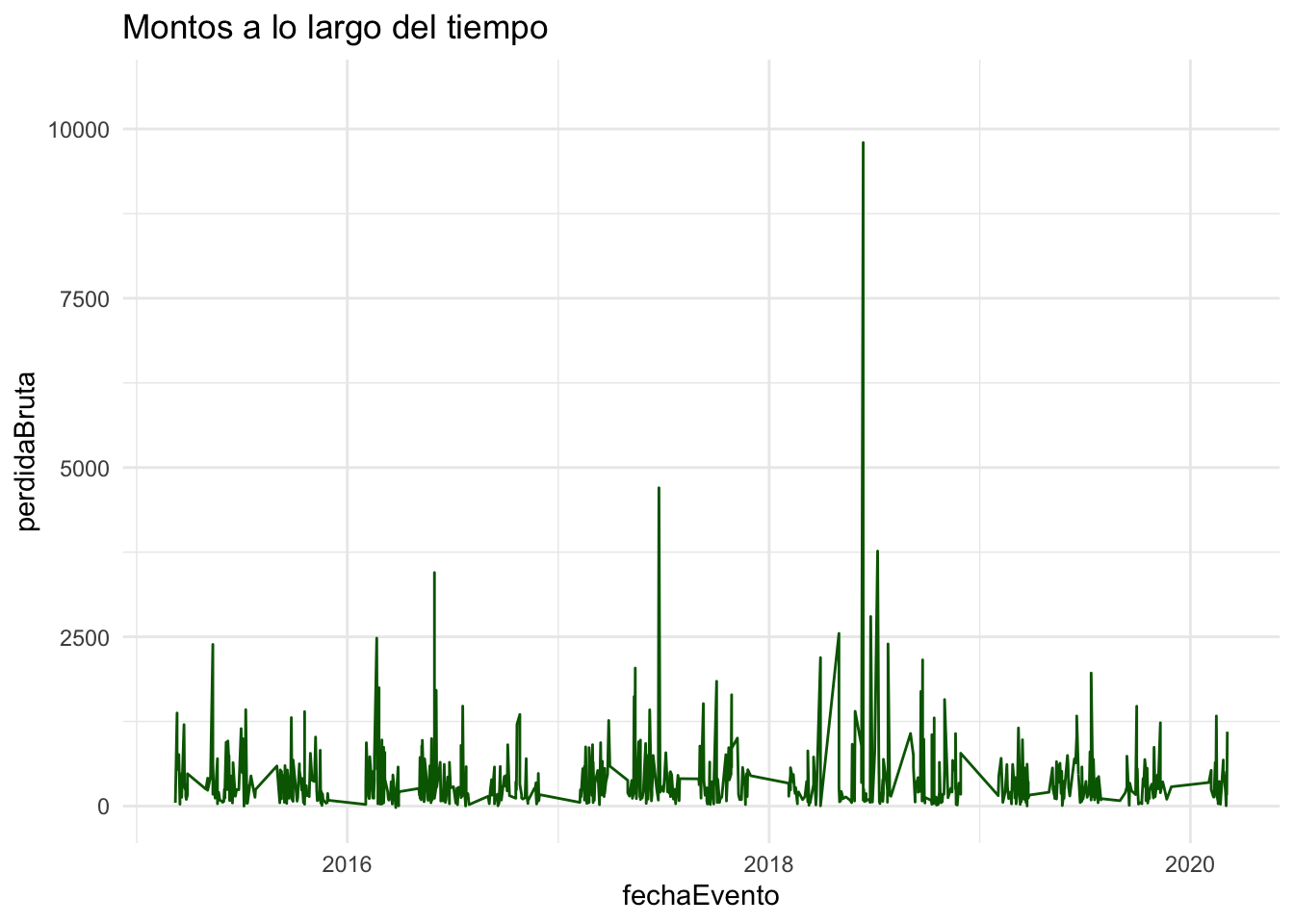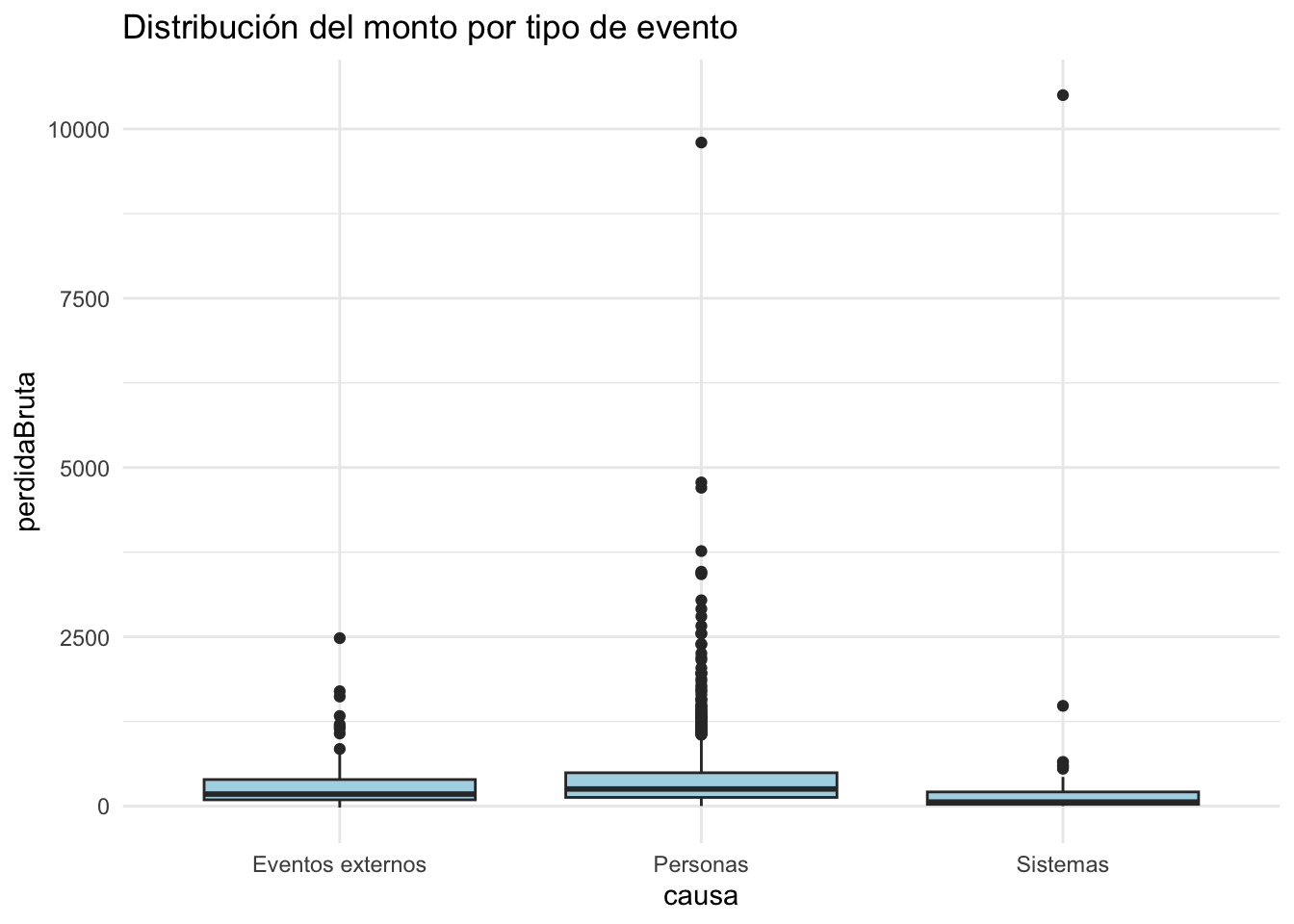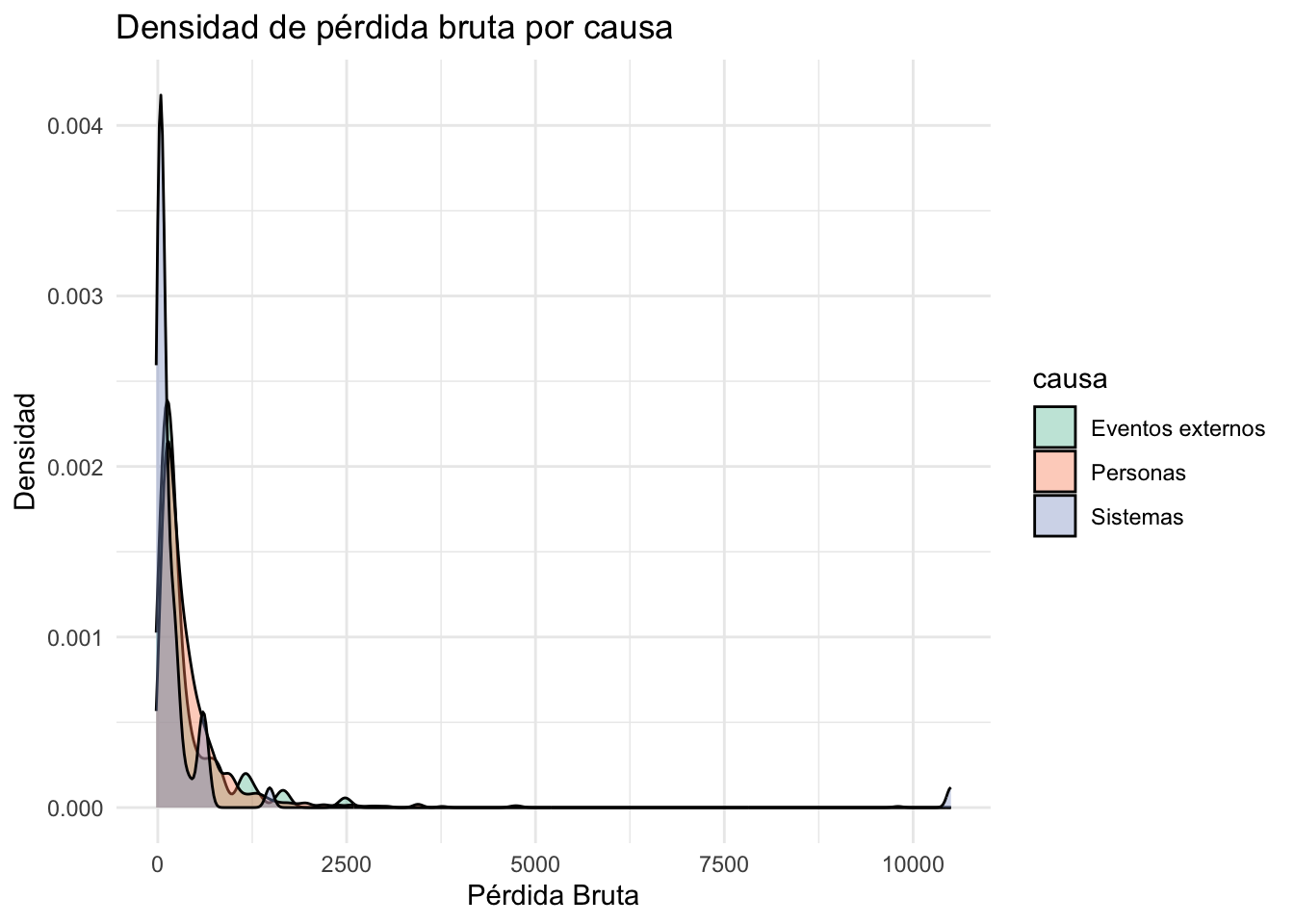Exploración inicial
## 'data.frame': 1117 obs. of 9 variables:
## $ unidadEjecutora : chr "Unidad de Finanzas y Contabilidad" "Unidad de Operaciones -Préstamos" "Unidad de Administración y Recursos Humanos" "Unidad de Negocios Costa Rica" ...
## $ fechaEvento : Date, format: "2018-06-14" "2016-09-07" ...
## $ perdidaBruta : num 247 390 296 195 243 ...
## $ recuperacion : num 0 0 0 0 0 0 0 0 0 0 ...
## $ perdidaReconocida: num 247 390 296 195 243 ...
## $ detalleNivel3 : chr "7.1.3 - Incumplimiento de plazos o de responsabilidades" "2.1.1 - Hurto/ robo" "1.2.5 - Falsificación" "7.5.1 - Fallos de contrapartes distintas de clientes" ...
## $ detalleNivel2 : chr "7.1 - Recepción, ejecución y mantenimiento de operaciones" "2.1 - Hurto y fraude" "1.2 - Hurto y fraude" "7.5 - Contrapartes comerciales" ...
## $ detalleNivel1 : chr "7 - Ejecución, entrega y gestión de procesos" "2 - Fraude externo" "1 - Fraude interno" "7 - Ejecución, entrega y gestión de procesos" ...
## $ causa : chr "Personas" "Eventos externos" "Personas" "Personas" ...
## unidadEjecutora fechaEvento perdidaBruta recuperacion
## Length:1117 Min. :2015-03-09 Min. : -21.57 Min. : 0.000
## Class :character 1st Qu.:2016-05-09 1st Qu.: 116.70 1st Qu.: 0.000
## Mode :character Median :2017-07-04 Median : 239.08 Median : 0.000
## Mean :2017-07-31 Mean : 405.68 Mean : 8.846
## 3rd Qu.:2018-10-21 3rd Qu.: 478.17 3rd Qu.: 0.000
## Max. :2020-03-05 Max. :10500.00 Max. :739.070
## NA's :390
## perdidaReconocida detalleNivel3 detalleNivel2 detalleNivel1
## Min. : -21.57 Length:1117 Length:1117 Length:1117
## 1st Qu.: 119.74 Class :character Class :character Class :character
## Median : 242.52 Mode :character Mode :character Mode :character
## Mean : 414.06
## 3rd Qu.: 482.10
## Max. :10500.00
##
## causa
## Length:1117
## Class :character
## Mode :character
##
##
##
##
sapply(datos, function(x) sum(is.na(x)))
## unidadEjecutora fechaEvento perdidaBruta recuperacion perdidaReconocida
## 0 390 0 0 0
## detalleNivel3 detalleNivel2 detalleNivel1 causa
## 0 0 0 0
Visualización general
ggplot(datos, aes(x = perdidaBruta)) +
geom_histogram(bins = 30, fill = "steelblue", color = "white") +
theme_minimal() +
labs(title = "Distribución de pérdida bruta")

ggplot(datos, aes(x = fechaEvento, y = perdidaBruta)) +
geom_line(color = "darkgreen") +
theme_minimal() +
labs(title = "Montos a lo largo del tiempo")

Pruebas de normalidad
shapiro.test(datos$perdidaBruta)
##
## Shapiro-Wilk normality test
##
## data: datos$perdidaBruta
## W = 0.4708, p-value < 2.2e-16
Pruebas de hipótesis por causa
# Obtener los niveles únicos
niveles <- unique(datos$causa)
niveles
## [1] "Personas" "Eventos externos" "Sistemas"
# Función para pruebas por pares
for (i in 1:(length(niveles)-1)) {
for (j in (i+1):length(niveles)) {
cat("\n============================\n")
cat("Comparación:", niveles[i], "vs", niveles[j], "\n")
grupo1 <- datos$perdidaBruta[datos$causa == niveles[i]]
grupo2 <- datos$perdidaBruta[datos$causa == niveles[j]]
# t-test
cat("\n--- t-test ---\n")
print(t.test(grupo1, grupo2, var.equal = FALSE))
# Wilcoxon
cat("\n--- Wilcoxon test ---\n")
print(wilcox.test(grupo1, grupo2))
# Kolmogorov-Smirnov
cat("\n--- KS test ---\n")
print(ks.test(grupo1, grupo2))
}
}
##
## ============================
## Comparación: Personas vs Eventos externos
##
## --- t-test ---
##
## Welch Two Sample t-test
##
## data: grupo1 and grupo2
## t = 1.34, df = 110.28, p-value = 0.183
## alternative hypothesis: true difference in means is not equal to 0
## 95 percent confidence interval:
## -32.85096 170.04677
## sample estimates:
## mean of x mean of y
## 415.8205 347.2226
##
##
## --- Wilcoxon test ---
##
## Wilcoxon rank sum test with continuity correction
##
## data: grupo1 and grupo2
## W = 46858, p-value = 0.02226
## alternative hypothesis: true location shift is not equal to 0
##
##
## --- KS test ---
## Warning in ks.test.default(grupo1, grupo2): p-value will be approximate in the presence of
## ties
##
## Asymptotic two-sample Kolmogorov-Smirnov test
##
## data: grupo1 and grupo2
## D = 0.16085, p-value = 0.03662
## alternative hypothesis: two-sided
##
##
## ============================
## Comparación: Personas vs Sistemas
##
## --- t-test ---
##
## Welch Two Sample t-test
##
## data: grupo1 and grupo2
## t = 0.52566, df = 63.564, p-value = 0.601
## alternative hypothesis: true difference in means is not equal to 0
## 95 percent confidence interval:
## -247.3195 423.9199
## sample estimates:
## mean of x mean of y
## 415.8205 327.5203
##
##
## --- Wilcoxon test ---
##
## Wilcoxon rank sum test with continuity correction
##
## data: grupo1 and grupo2
## W = 46063, p-value = 1.399e-11
## alternative hypothesis: true location shift is not equal to 0
##
##
## --- KS test ---
## Warning in ks.test.default(grupo1, grupo2): p-value will be approximate in the presence of
## ties
##
## Asymptotic two-sample Kolmogorov-Smirnov test
##
## data: grupo1 and grupo2
## D = 0.44813, p-value = 9.6e-11
## alternative hypothesis: two-sided
##
##
## ============================
## Comparación: Eventos externos vs Sistemas
##
## --- t-test ---
##
## Welch Two Sample t-test
##
## data: grupo1 and grupo2
## t = 0.11349, df = 72.16, p-value = 0.91
## alternative hypothesis: true difference in means is not equal to 0
## 95 percent confidence interval:
## -326.3593 365.7639
## sample estimates:
## mean of x mean of y
## 347.2226 327.5203
##
##
## --- Wilcoxon test ---
##
## Wilcoxon rank sum test with continuity correction
##
## data: grupo1 and grupo2
## W = 3700.5, p-value = 3.697e-05
## alternative hypothesis: true location shift is not equal to 0
##
##
## --- KS test ---
##
## Exact two-sample Kolmogorov-Smirnov test
##
## data: grupo1 and grupo2
## D = 0.37302, p-value = 5.98e-05
## alternative hypothesis: two-sided
Correlaciones
cor.test(datos$perdidaBruta, datos$recuperacion, method = "pearson")
##
## Pearson's product-moment correlation
##
## data: datos$perdidaBruta and datos$recuperacion
## t = 1.9778, df = 1115, p-value = 0.04819
## alternative hypothesis: true correlation is not equal to 0
## 95 percent confidence interval:
## 0.0004741919 0.1173759177
## sample estimates:
## cor
## 0.05912777
Boxplot por tipo de evento
ggplot(datos, aes(x = causa, y = perdidaBruta)) +
geom_boxplot(fill = "lightblue") +
theme_minimal() +
labs(title = "Distribución del monto por tipo de evento")

ggplot(datos, aes(x = perdidaBruta, fill = causa)) +
geom_density(alpha = 0.4) +
theme_minimal() +
labs(title = "Densidad de pérdida bruta por causa", x = "Pérdida Bruta", y = "Densidad") +
scale_fill_brewer(palette = "Set2")




